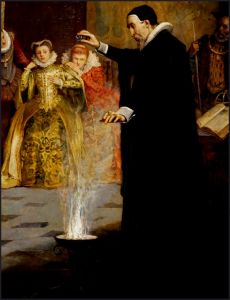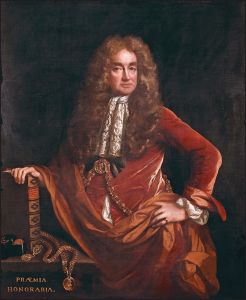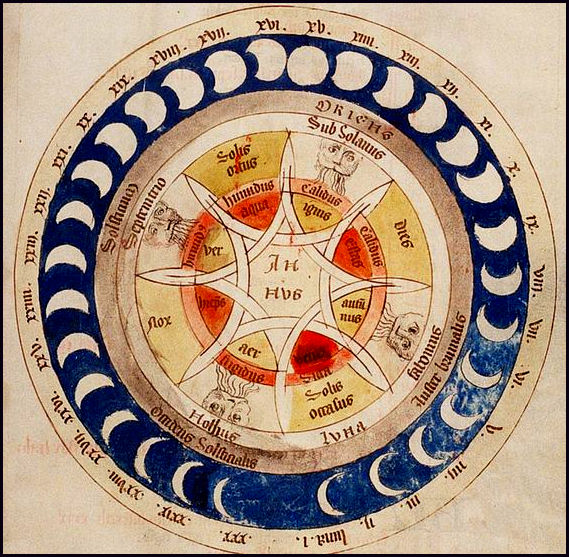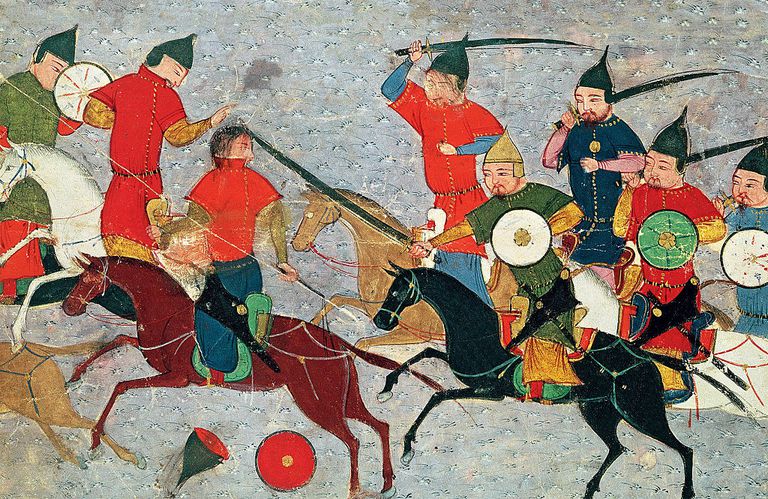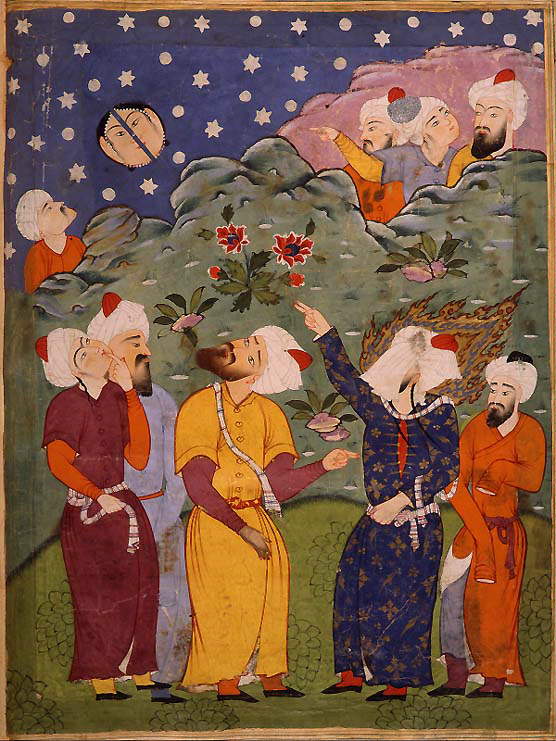It is He Who maketh the stars (as beacons) for you, that ye may guide yourselves, with their help, through the dark spaces of land and sea: We detail Our signs for people who know. (Surah Al-Anam, 97)

Lunar Calendar – detail of an almanac cover page. Topkapi Palace Museum Library, MS B 309. “This calendar was important in defining the times of religious observances that were new to the Muslim community. The Islamic religion, whose rituals were based on the lunar calendar, frequently calls the attention of Muslims to the heavens in the Koran, demonstrating the close relationship with astronomy in Muslim culture. ” Dr. Salim Ayduz (Muslim Heritage)
If you were to conduct a search on the subject of Islam and Astrology, you find several rulings by Muslim scholars. It is neither my place nor my interest in contradicting them. But I take exception to the way that astrology is falsely presented and I mean to show how the art is a part of the Islamic experience. This passage will serve to provide a fair representation of the position of the naysayers:
“Not only is the practice of astrology is [sic] haram, but also visiting an astrologer and listening to his predictions, buying books on astrology or reading one’s horoscope are also forbidden. Since astrology is mainly used to predicting the future, those who practice it are considered fortune-tellers. Consequently, one who seeks his horoscope comes under the ruling contained in the Prophet’s statement. ” (See Sunnah Online). The prophet’s statement is concerned with fortune-tellers and the annulment of prayers for those who visit one.
When the passage is distilled, we find that the chief complaint is that astrologers predict the future. For now, I will simply state that predictions are also made by the weather bureau, ordinary farmers, physicians, political commentators and so on. The is no supernatural force at work, although as with the other livelihood a knowledge of the subject and a keen intuition are part of the skill. I mean to address this and other issues regarding what is haram or halal with respect to the celestial sciences.
To begin, I will attempt to create a rough context for the practise of astrology in Islam, recognizing that this is the same or identical in other faiths. The question of whether or not astrology is permitted in Islam is not a simple question by any means. I have worked to place the question in the context of various forms of Islamic understanding, including the Quran itself. I find that the question isn’t so much whether astrology is haram or halal, but how astrology is interpreted in the first place.
This is a key passage:
“Your Guardian-Lord is Allah, Who created the heavens and the earth in six days, and is firmly established on the throne (of authority): He draweth the night as a veil o’er the day, each seeking the other in rapid succession: He created the sun, the moon, and the stars, (all) governed by laws under His command.s it not His to create and to govern? Blessed be Allah, the Cherisher and Sustainer of the worlds! “(Surah Al-Araf, 54)
There is no question that the stars and planets are governed by laws that are above them. Plato, Plotinus, Aristotle, Ficino, Hinduism, the Abrahamic faiths along with all Islamic astrologers agree on that. This is why it is completely wrong-headed to consider authentic astrology as idolatry or placing the Creation above the Creator. That isn’t how it works.
The passage is a clear parallel to Genesis, which shouldn’t be surprising. There were large Jewish communities in centers like MekKa and Medina at the time of Muhammad. At the same time, the epithets for Allah – “Cherisher and Sustainer of the worlds’ sounds more Hindu than Jewish. This is what Hindus call Vishnu. I make this comment to get the idea across that ancient Arabia was a culture of trade and with trade go ideas. They were not isolated.
Again this is made plain: “He has made subject to you the Night and the Day; the sun and the moon; and the stars are in subjection by His Command: verily in this are Signs for men who are wise. (Surah An-Nahl, 12)
There is no more fundamental belief in Islam than the concept of Tawhid. Islamic scriptures are replete with This is but one. Here we have the instruction to “follow what thou art taught by inspiration from the Lord: there is no god but He: and turns aside from those who join gods with Allah. (Surah Al-Anam, 106). A term related to this is shirk – attributing partners to Allah. It would take either a great misunderstanding of Islam and astrology to conclude that the wisdom conveyed via the stars denies the oneness of Allah.
The modifier “Sign for men who are wise” is crucial. Without special knowledge and insight, the further dimensions of meaning remain hidden. Indeed, there is no reason why everyone would need to know the greater workings of the celestial science.
Nevertheless, everyone needs to know the everyday calendrical information. In Islam, the Moon is of great significance for this and many other reasons, as the flags and mosque symbols of Islam attest. In the desert the Sun is pitiless and the cool of the evening a welcome respite. Pre-Islamic Middle Eastern lunar deities were ubiquitous and often considered male.

The image shows the phases of the moon in a month. This is a page taken form a calendar prepared by Sayyid Ahmed b. Mustafa Al-La’li, who presented this calendar to the Sultan Selim II in 1566. Courtesy of Sam Fogg – London.
Classical astrologers have learned much of what they know from the ancient sources of the Middle East, Greece, Persia & India. In what were the European Middle Ages and Renaissance, Islamic astrology came into what has become known as a Golden Age. So the question as to whether or not Islam permits the use of astrology isn’t likely to trouble many practitioners.
I do not write this article with a mind to changing anyone’s point of view. I would, however, like to make it as clear as possible how classical astrologers, including historical Islamic ones, understand their own craft. In doing so, I make one short digression. The idea of belief is itself somewhat problematic. It lies somewhere in a grey area between faith and the void. We might also say that it’s like faith without understanding. For example, do I have to ‘believe in’ mathematics in order for it to work? Probably not. However, I’m not likely to derive much utility from mathematics if I refuse to employ the tools it offers. Belief has no sincere interest in the examined truth and is content to accept what others have said is true. The apprehension of truth takes time and effort. If this were not true, the world would have far fewer bigots.
The unexamined life is not only not worth living, it is scarcely a life at all. Sometimes the question is as important as the answer. It very often happens that one is like the proverbial fish in the bowl, not cognizant of the fact that he is swimming in water because there is no experience of otherness to create that awareness.
I was impressed by a very fine article “Is Astrology Permissible in Islam.” by Ugur Alkan, a freelance writer who holds a B.A. in Communication and an MBA in Management from Fort Hays State University, Kansas. The article is well written, but what attracted me most to the article was the stark boldness of the title in the form of a question. To some extent, this article is a response and dialogue with Alkan.
Alkan rightly points out at the beginning of the article that:
“Islam, like Christianity and Judaism, condemns fortune-tellers and praise genuine sciences. In The Holy Koran, Surah Al-Maida commands “Forbidden also is to use arrows seeking luck or decision; all that is disobedience of Allah and sin”, Quran 5:3. In this case, the critical question involves the application of astrology. Is it used to find propitious times in our lives or to benefit as a helping profession in social and psychological sciences? According to some scholars in Sufism (Islamic Mysticism), astrology may be permissible in Islam because it is neither illusion nor demonic practice. Instead, astrology is based on statistical knowledge which motivates people for further research and comprehension of the human condition.”
The implication is that the two chief reasons for rejecting astrology are that it is either an illusion or else demonic. The first stems from a fundamental misunderstanding of how astrology works. Many have argued, for example, that the planets cannot possibly affect us because they are too far away. Even Jupiter’s gravity cannot reach us. The planets are just rocks in space. Usually, that’s where the investigation ends. However, the planets don’t ‘do’ anything to us. The Quran also makes this plain. The celestial bodies are guides to the wise. The best analogy that comes to mind is that of a clock. The clock doesn’t ‘make’ time, but it can tell us what time it is. Those who seriously want to know how astrology can work will find scores of articles on this blog, dealing with that question in one way or the other

Imam Ali Conquers Jinn, unknown artist, Ahsan-ol-Kobar (1568) Golestan Palace
The demonic issue appears to be more complex in Islam than in the other Abrahamic religions because Islam includes the Jinn. One is not free to imagine there are no Jinn, any more than one is free to deny the existence of angels. These are elements of the Islamic faith. They are as much a part of Islam as who vastly outnumber humans and are invisible unless they choose to take a particular form. They are smokeless fire beings associated Iblis, the Islamic Lucifer. However, there are apparently many beneficial Jinns. The prophet Sulyman employed Jinn to great effect and this is celebrated in the Quran. They have also been associated with arts such as astrology. We are then faced with the situation of interrogating Hamlet’s ghost to determine whether the spirit is good or evil – a liar or a speaker of the truth. Although one might turn this into an impossible quest, thwarted at every step by the haunting possibility that a bad Jinn is deceiving us into believing it good, there is a way through. We can know what is good by what it produces. If true astrologers can provide medical insights, auspicious dates for doing anything from starting the building of Baghdad to planting celery, identifying areas of conflict between nations and between a brother and sister, we ought to rule out the agency of evil beings.
Jinn vastly outnumber humans and are invisible unless they choose to take a particular form. They are smokeless fire beings associated with Iblis and they can live for several hundred years.
However, there are beneficial Jinn. The prophet Sulyman employed Jinn to great effect and this is celebrated in the Quran. They have also been associated with arts such as astrology. We would otherwise be faced with the situation of interrogating Hamlet’s ghost to determine whether the spirit is good or evil – a liar or a speaker of the truth. Although one might turn this into an impossible quest, thwarted at every step by the haunting possibility that a bad Jinn is deceiving us into believing it good, there is a way through. We can know what is good by what it produces. There is nothing particularly different about this than things we do every day. A good recipe is judged by what the dish tastes like. If true astrologers can provide medical insights, auspicious dates for doing anything from starting the building of Baghdad to plating celery, identifying areas of conflict between nations and between a brother and sister, we ought to rule out the agency of evil beings. However, I’m in no position to deny that some forms of mediumship involving an alleged communication with spirits is mere fiction. Such is neither my expertise or interest.
Although one might turn this into an impossible quest, thwarted at every step by the haunting possibility that a bad Jinn is deceiving us into believing it good, there is a clear way through. We can know what is good by what it produces. If competent astrologers can provide invaluable medical insights, auspicious dates for doing anything from starting the building of Baghdad to planting celery, predicting the weather, identifying areas of conflict between nations and between a brother and sister, we ought to rule out the agency of evil beings.
In the Tasfir of Ibn Khatir – Imam Ahmad recorded from Az-Zubayr that he commented on the Ayah:
“A group of [Jinn] went towards Tihamah and found Allah’s Messenger while he was at a place called Nakhlah along the way to the `Ukaz market. He was leading his Companions in the Fajr prayer. When the Jinns heard the recitation of the Qur’an, they stopped to listen to it, and then they said: `By Allah! This is what has prevented you from eavesdropping on the news of the heavens.’ Then they returned to their people and told them: `Our people! We certainly have heard an amazing recitation (the Qur’an), it guides to the right path. So we have believed in it, and we will join none in worship with our Lord.’ So Allah revealed to His Prophet,”
﴿قُلْ أُوحِىَ إِلَىَّ أَنَّهُ اسْتَمَعَ نَفَرٌ مِّنَ الْجِنِّ
That the Quran was a revelation to both humans and the Jinn is a central element in Islamic thought. There is a very moving document from the 15th Century that has the animals of the world pleading to the King of the Jinn for humans to treat them better. There is a copy in the archives
Yet the Jinn are not be universally trusted by any means. There is an Islamic account, which might be apocryphal, that nevertheless holds a lot of weight. The story goes that angels get together to discuss the future, only to be overheard by evil Jinn who then corrupt the truth while leaving enough factual content to deceive the fortune teller and impress the querent.

The Stars and Human Temperaments – this model, derived from Greek sources, such as Galen and explains the theory that illustrates correlations between celestial bodies and human temperaments. This was well-received throughout the Islamic world.
“The word Jinn means “hidden” in Arabic. In The Holy Koran, they are described as being created from smokeless fire. Jinns are the descendants of Satan like Humans are descendants of Adam but most of them are very deceptive and dangerous for humans. When God has a certain event planned in our lives, he commands the angels to create the conditions to fabricate them. Before implementing God’s plan, Angels discuss this future event. In some cases, jinn sneaks up and overhear the future event and passes this information to the fortune-tellers through Tarot, I-ching or any other objects. Of course, the Jinns don’t intend to be favourable of humans; therefore, they muddle up the truth of future events with deception. As a result, the truthful events overheard from Angels are embellished with lies to cause confusion.” (Alkan).
Further to this view, we find a great deal of confirmation for credence in astrology as such:. “In Islamic teachings, every prophet was gifted with diverse miracles. Prophet Idris, also known as Enoch in the Old Testament, was blessed with his immense knowledge of heavenly sciences. As compared to modern science, he had a more complex knowledge of astronomy. Some Sufi schools consider him as the founder of the science of the stars, also called “ilm al nujum” in Arabic. Historical records illustrate his birth in Babylonia and his migration to Egypt later in life. History also collaborates that astrology was first born in Babylonia and then spread to Egypt. Prophet Idris was supposedly known to be the first person to educate mankind that living creatures are under the influence of cosmic rays.”
“In Islamic teachings, every prophet was gifted with diverse miracles. Prophet Idris, also known as Enoch in the Old Testament, was blessed with his immense knowledge of heavenly sciences. As compared to modern science, he had a more complex knowledge of astronomy. Some Sufi schools consider him as the founder of the science of the stars, also called “ilm al nujum” in Arabic. Historical records illustrate his birth in Babylonia and his migration to Egypt later in life. History also collaborates that astrology was first born in Babylonia and then spread to Egypt. Prophet Idris was supposedly known to be the first person to educate mankind that living creatures are under the influence of cosmic rays.” (Alkan)
Alkan then refers to modern horoscopes wherein the Sun is regarded as the only star and therefore the knowledge that belonged to the ancients is lost. First of all, no serious astrology considers newspaper horoscopes as having anything to do with authentic astrology. True practitioners of the art pay a great deal of attention to fixed stars.
For some, this may be all the scriptural references to prophets such as Daniel and Enoch may be all they need to accept the halal relevance of reading the stars. However, it is very difficult for many people to understand the difference between fortune-telling and authentic astrology. In large part, the difference is not merely in the technique, but in the intent. If I say we are in for a very cold winter because I have learned how to read the signs of nature, such as the curling of leaves or the activity of crows, I’m merely stating that this is what happens when these signs manifest. This kind of divination is common among people who interact with and live close to nature. In fact, a Muslim colleague from Pakistan once told me that reading the stars is reading the signs of nature. If this is the case, astrology doesn’t differ much from meteorology. To refer to it as polytheistic is to completely misunderstand the nature of astrology.
But what if I say you will meet a man in a white suit on Sunday 21 August. He has brown eyes and you will marry him? Here, we have gone from reading the signs of nature and no matter what technique is used there are several problems. We are talking about humans here and humans have choices to make. Even if this mas were to show up on this date in that suit, neither of you have indicated an interest in marriage. Can the reader be certain that the man won’t spill chocolate sauce over his suit, causing him to change it? The point here is that we are not really reading the signs of nature – I do not know of an astrologer who could predict with such personal detail, for a specific date. It is on these occasions that dark forces might be implicated, not only with Muslims but other belief systems as well. It is precisely because we cannot point to the action of crows of the entrance of a planet into a new sign, to explain the findings.

Muhammad Splits the Moon
A great deal is riding on the answer to the simple question “is astrology permitted in Islam.” This question ultimately goes far beyond astrology itself. There are very many sub-sects of Sunni and Shia Islam, There are many Muslims who insist that music is haram, yet music and dance are very much part of the Islamic legacy.
Some groups in Pakistan and Sub-Saharan Africa, for example, systematically destroy Sufi shrines or anything at all that could leave the impression that Sufism was ever a part of regional cultures. Islam has taken the Abrahamic hatred for idolatry to the most extraordinary heights, being seemingly unable to distinguish between the evocative value of art from the worship of idols at all. This was why the Bamiyan Buddhist statues were destroyed. It was considered a holy act and I think they were sincere, even if regrettably misguided. The world lost an extraordinary heritage site, going back to the Buddhist period of what is now called Afghanistan, but to a literalist who considers all religions but his own as idolatrous, their destruction was an act of piety.
The answer, if you get one at all, to the question: is astrology permissible in Islam will depend on who you ask, which source texts they consult and how they interpret them. All three criteria are subject to a multitude of considerations. I have been in touch with various Islamic scholars over the years and while most will deny that Islam supports astrology, there have been a few that do. In all cases of those who rejected astrology, I found that they had a vastly different concept from me regarding what astrology actually is. Although there is a rich tradition of astrological use, including from highly respected Islamic sources. The fact that the timing of the construction of Baghdad was trusted to astrologers and that medicine was so inextricably connected to astrology appears to be better known outside of Islam than within it. Clerics differ wildly on many subjects, but with respect to astrology, polarized views are adamantine. Attempts to explain the true nature of astrology are mostly doomed before they begin. One of the fruitful paths is to show how astrology has been used by Muslims and particularly during what is considered the Golden Age of Islam.

Canopus the “Celestial Navigator.” – The star used for the orientation of the Kaaba. Canopus shines 1400 times brighter than our Sun.
Take for example the celebrated “Book of Wonders” by Zakarīyā ibn Muhammad al-Qazwīnī (circa 1203–83). He was a distinguished Iranian scholar who was conversant in poetry, history, geography, and natural history. He served as legal expert and judge in several localities in Iran and at Baghdad. After travelling throughout Mesopotamia and Syria, he wrote his famous Arabic-language cosmography, ‘Aja’eb ol-makhluqat wa qara’eb ol-mowjudat (The wonders of creation, or literally, Marvels of things created and miraculous aspects of things existing).
This treatise has been translated into Persian, Turkish, and German and is concerned with subjects such as astrology, cosmology, and the natural sciences. The author was very fond of Pliny the Elder and other Greek classical works. as well as the rich sources then found in the Middle East, Northern Africa, and India.

“Book of Wonders” by Zakarīyā ibn Muhammad al-Qazwīnī (circa 1203–83).
This is but a drop in the ocean. Masters of several arts, like Ibn Sina, born in what is now Uzbekistan, wrote voluminous medical works filled with thousands of pages of pharmacopoeia and used even in Europe until a bit more than a hundred years ago. He was also an astrologer and he used this as an integral part of his medical practise. He spoke several languages, was extraordinarily well versed in philosophy and theology among many other things. His correspondence with Al Biruni is extant and illuminating, for anyone wishing to get a deeper insight into the Islamic culture of the period.
There is a statement attributed to Hippocrates, although the written location of the quote remains a mystery. Nevertheless, it is by no means out of place with what we know about Greek humoral medicine. This was certainly taken to heart by Islamic translators of Hippocrates, Galen and others.: “A physician without a knowledge of astrology has no right to call himself a physician” We can also look forward to Guido Bonatti and others who were instrumental in the transmission of Islamic astrological ideas and methodologies. Bonatti was a great influence on the English Astrologer, William Lilly, who in turn imparted medically relevant knowledge to Nicholas Culpeper (1616-1654). Culpeper was a friend and student of the astrologer William Lilly who worked with Culpeper on the attribution of astrological characteristics of both herbs and the patients being treated. What is seldom mentioned is that Culpeper knew of Avicenna and had access to his work. Culpeper refers to this as “astrologo-physical discourse of the vulgar herbs.” In his most celebrated work on medicine, The English Physician (1652), Culpeper’s lays out the relationship between plants and astrological considerations in the service of medicine.
The uses of authentic astrology are immense and have been passed on for the most part in scrupulous detail. This is not to say that the tradition is a monolith that can never be changed. In the words of Gustav Mahler: “tradition is not the worship of ashes, but the preservation of fire. ” In this case, the tradition involves a number of disciples working together. We need to be clear that astrology was “NOT a hobby you performed in your spare time. It required a very good grasp of mathematics, astronomy, and writing, among many other things. Ergo, something you would
definitely not encounter among the general populace, as it would have required academic studies proportionally arduous to what you’d find today- the content might have been different, but you’d have to learn critical thinking, defending your theories, and learn about all the available material that preceded their “modern” education.” (Sid Meier’s Civis.)

Abū-ʿAlī al-Ḥusayn ibn-ʿAbdallāh Ibn-Sīnā [Avicenna]
Avicenna’s breadth of learning is extraordinary by any standard. His importance is summed up in this entry in the
Stanford Encyclopedia of Philosophy:
“Avicenna synthesized the various strands of philosophical thought he inherited—the surviving Hellenic traditions along with the developments in philosophy and theology within Islam—into a self-consistent scientific system that explained all reality. His scientific edifice rested on Aristotelian physics and metaphysics capped with Neoplatonic emanationism in the context of Ptolemaic cosmology, all revised, re-thought, and critically re-assessed by him. His achievement consisted in his harmonization of the disparate parts into a rational whole, and particularly in bringing the sublunar and supralunar worlds into an intelligible relation for which he argued logically. The system was therefore both a research program and a worldview.”
Al Biruni spoke several languages, wrote an incredibly detailed and insightful book on the history, religion, and philosophies of India was also an extraordinary astrologer and is still studied today. There are dozens of others that can be cited, but this will not convince anyone who has decided that astrology is haram. Indeed, many of the most brilliant minds in Islam were accused of heresy and/or exiled.

Page from Avicenna’s Canon of Medicine – Courtesy of The National Library of Medicine
Muslims often opine that the decline in Islam is a result of not following the literal interpretation of the Quran and Sunnah closely enough. In light of the achievements realized when Islam was a relatively open religion, respecting and admiring, for example, Classical, Indian and Persian antiquities, the appeal to fundamentalism as a cure for what ails Islam is not a case one can make without distorting history beyond recognition. The philosopher Al-Ghazali was rather like the Savonarola of Andalusia – except that Islam has not yet fully recovered from his eloquent but misguided call for literalism and fundamentalism, effectively closing the door on the extraordinary developments in Europe. If Averroes had won the debate, Islam would most likely have had its own Renaissance and Enlightenment. However, he lost and was sent into exile.
Of course, other religions, particularly some versions of Christianity have had their own iconoclasts and toters of pitchforks and torches, accusers and inquisitors. Even today I would wager that the vast majority of Christians would denounce astrology, if asked, only to check the horoscope in the newspaper because “it’s for entertainment only.” Few are aware that astrological ideas and imagery are woven into what was once called “high Church.” Many of the Popes had astrologers.

“Night Journey” attributed to Sultan Muhammad
This combined with a short survey of Qu’ran quotes will cause some to view astrology with an open mind and the rest will essentially go into a sort of denial. It’s very easy to find lists, for those interested.
Muhammad’s only son died at approximately age two and the passing coincided with a solar eclipse. Understandably, the father was stricken with grief, but he did something that might seem odd to us. He summoned all his companions.
“Prophet Muhammad wanted Arabs to eradicate the pre-Islamic era paganism and superstitious beliefs. Distraught by the death of his son, he gathered his community and told them that solar eclipse is an irrelevant event and does not occur in correlation to someone’s birth or death. The experience of Prophet Muhammad is considered proof that there is no celestial influence or synchronicity between such phenomenon and human events. ” (Alkan) This may well seem to contradict the Quran, but it does, in fact, agree with it. A single and fleeting astrological event like this shouldn’t be blamed on the eclipse.
The story of Muhamad urging his followers not to consider the eclipse as in any way related to the death of his son, because that is a pre-Islamic superstition isn’t a reason in itself That is to say one cannot divine that something is a mere superstition just by saying so. The understanding and accurate forecasting of eclipses preceded Islam by thousands of years. The pre-Islamic astronomers were sophisticated enough to name and track the unfolding of saros cycles. At the same time, we are asked to believe that the prophet literally split the Moon into two pieces. We are also told that shooting stars (comets or meteorites) “are made as “lamps as missiles to drive away the shayatin (devils).” Al-Qur’an 67:5

Eclipse Lunar Moon phases and eclipse illustrated by the great tenth-century Persian scholar Al-Biruni.
For many years, I assumed that all Muslims took these stories as metaphors od a mystical experience as do I. The alternative is rife with problems, even more so than the Night Journey. The prophet literally flew to Jerusalem on the back of the buraq steed. met all the Abrahamic prophets and returned without being seen. Again, as a metaphor, it’s a wonderful story, but if I have no choice than to believe it’s literally true, that’s all well and good, but one cannot then claim a distaste for faith-based on unverifiable facts. It is impossible to ignore the fact that before and after the prophet, there was a highly evolved science of the stars that had precious little to do with superstition with demonstrative techniques and stunning accuracy.
I cannot help but think that Muhammad knew this. Perhaps the story has become corrupted over the years because the Quran is not so dismissive. Also, as a merchant, he had travelled a great deal and interestingly included the Chaldeans along with the People of Book. Abraham himself is said to have come from Ur of the Chaldees. The name Chaldean is virtually synonymous with astrology and we still refer to the Chaldean order of the planets. The Chaldean star lore derived from Egypt, Persia, and India, but they no doubt influenced these cultures as much as they were informed by them. It is impossible to imagine that the prophet was unaware of the core of their beliefs of the Sabians (/ˈseɪbiənz/; Arabic: الصابئة al-Ṣābiʼah or الصابئون al-Ṣābiʼūn). The religious group is mentioned three times in the Quran as a People of the Book: ie “the Jews, the Sabians, and the Christians”
“It is supposed that they influenced the practices of the Hellenic Theosebeis. While their angelology was based around the movements of the Sun, Moon, Mars, Mercury, Jupiter, Venus and Saturn. They found its greatest development in the community which was based in the Harran region of south-eastern Anatolia and northern Syria, who were distinguished as the Sabians of Harran from the south Mesopotamian Sabi’una Hunafa by later Islamic writers like Ibn al-Qayyim” (Creative Commons). It isn’t unusual to think of the planets and luminaries as angels or messengers. Indeed, that is the most common understanding of the part they play in astrology among traditional astrologers from virtually all traditions.

Sabian “Star-Worshipers.”
The Sabians are a monotheistic religious group who worshipped in the names of stellar angels. This religion understandably became confused with the worship of the celestial bodies themselves, rather than their creator, as the dwellings or mansions of the powers above the visible orbs. Sabeanism was one of the archaic religions found all over the world in different forms. In its origins, Sabianism was undoubtedly a continuation of the rich tradition of star lore in the Middle East which go back to deepest antiquity. There was a later tradition that tells us that Muhammad was himself a Sabian before his conversion. The Sabians are monotheistic and the celestial world was of the utmost importance to all groups in the region and far beyond it. It is interesting that Canopus is used as the star of orientation regarding the Kaaba because the star is known as the Celestial Navigator. The greatest irony, of course, is that Muslims who consider astrology haram, really don’t know what it is.
The question of whether or not astrology is permitted in Islam, will, of course, be the decision of individual Muslims as well as sects of Islam. Nevertheless, from an objective point of view, the fact that astrology has been integral to the development of Islam and was used by its most brilliant proponents is compelling. The Quran itself is replete with variations on the idea that the Stars are guides for the wise. Beyond that, I sympathize and understand potential problems in the misuse of astrology.

Jupiter and Mercury Conjunction Personified
The first part is the need for the discernment of spirits, as it is known in European cultures, but in fact, emphasized by St. Paul. The true astrologer is conscious. The techniques take many years to learn, and much more to master, but in the end, one cannot dispel higher intuition out of the nexus. One needs to be clear with potential clients who treat astrology as of it were a slot machine or something to enforce an illusion. Astrology is good and strong medicine, but like any medicine, the quality of the practitioner is the greatest consideration.
!
.
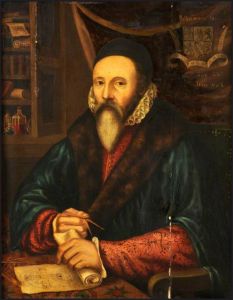
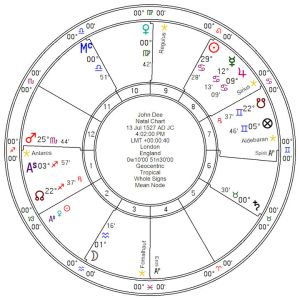
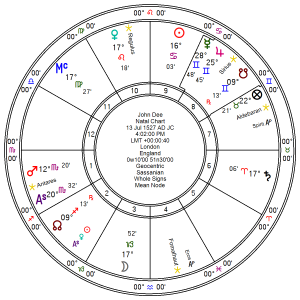 The Sun remains in Cancer but is now in the ninth house, as would be expected of someone who travelled widely in the pursuit of philosophical knowledge. Notably, Dee was perhaps the foremost expert on marine navigation of his time. and is justly credited with being influential in England’s developing naval prominence, most famously regarding his alleged role in the defeat of the Spanish Armada, but in a larger sense the firm idea of an Empire based on naval dominance.
The Sun remains in Cancer but is now in the ninth house, as would be expected of someone who travelled widely in the pursuit of philosophical knowledge. Notably, Dee was perhaps the foremost expert on marine navigation of his time. and is justly credited with being influential in England’s developing naval prominence, most famously regarding his alleged role in the defeat of the Spanish Armada, but in a larger sense the firm idea of an Empire based on naval dominance.